Triggered Nation: The Neurology of Trump’s American Redpill
How Donald Trump uses the brain’s threat system to keep America entrapped by fear.
Over the last several months, I’ve built a model for understanding the psychological impact and emotional control of Donald Trump and his regime over the American population, drawing from disciplines including psychology, psychiatry, behaviorism, epistemology, semiotics, philosophy, and history.
But how does this actually work in the physical brain?
I believe a very important part of the answer lies in the way signals are encoded and processed in the brain, and the timing of how they are prioritized.
Neuroscience of Threat
The chief rhetorical toolkit of Donald Trump and his regime is threat. They have created an alternate reality composed of threats to Americans that are either entirely fabricated, like “Antifa,” or completely blown out of proportion, like “illegal aliens.”
Human beings are extremely advanced at detecting threats and preparing for new ones. But the systems that evolved over millions of years to handle threats have not adapted to the sensory overload presented by 21st century technology. To understand how modern propaganda penetrates consciousness, we have to look at how the brain decides what to feel before it decides what to think.
Dual Route to Amygdala
In their 2012 paper, Garrido et al. presented “Functional Evidence of a Dual Route to Amygdala” which supports the idea that “an expedited evaluation of sensory input is best explained by an architecture that involves a subcortical path to the amygdala.“
Subcortical means that the input skips past the cortex—the conscious, reflective mind—and heads straight to the subconscious fear center, the amygdala. In 2021, Kragel et al. published a paper that zeroed in on the pathway.
Activity in this pathway encodes… negative images and sounds, but not pleasant images or painful stimuli. These results provide a functional description of a human ‘low road’ pathway selective for negative exteroceptive events…
As an example of how this works in specific sensory systems, James A. Carr wrote in Neuroendocrine Science “I’ll take the low road: the evolutionary underpinnings of visually triggered fear” (2015) about how the dual route pathway evolved in visual processing for non-conscious threat detection.

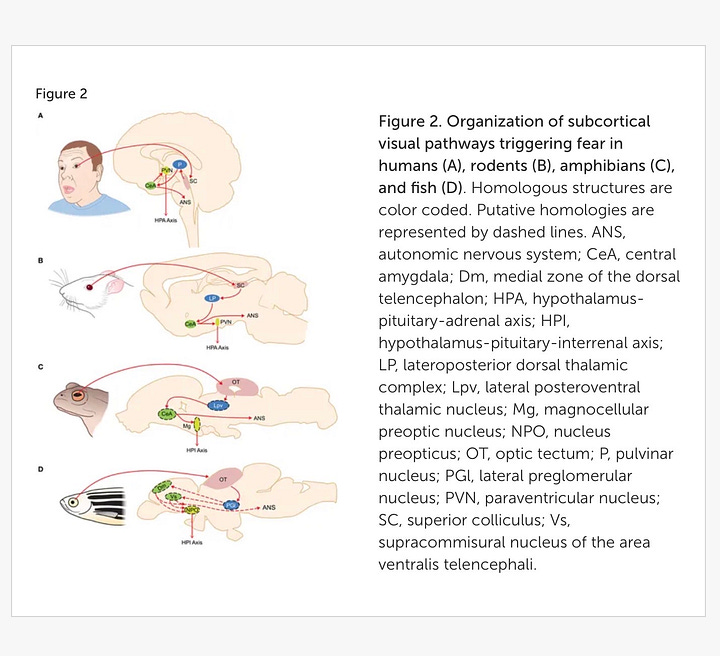
Emotional “Tagging”
This dual route architecture relies on a process of “tagging” incoming information based on a “salience network” stored in the insular cortex (Menon et al., 2010).
The model we present postulates that the insula is sensitive to salient events, and that its core function is to mark such events for additional processing and initiate appropriate control signals. The anterior insula and the anterior cingulate cortex form a “salience network” that functions to segregate the most relevant among internal and extrapersonal stimuli in order to guide behavior.
In effect, the salience network decides what signals require attention—and which can safely be ignored.
Emotions and Memory
This salience network is heavily affected by emotional states and memory formation.
In 2017, Tambini et al. showed that:
neutral stimuli encountered by human subjects 9-33 min after exposure to emotionally arousing stimuli had greater levels of recollection during delayed memory testing compared to those studied before emotional and after neutral stimulus exposure. Moreover, multiple measures of emotion-related brain activity showed evidence of reinstatement during subsequent periods of neutral stimulus encoding.
This means that it’s not just the emotional experience made more salient through memory formation; emotion increases memory formation of neutral information both before and after, indicating “an emotional experience can persist in and bias how new, unrelated information is encoded and recollected.”
PTSD and Fear
Over time, persistent emotional stress can overstimulate this threat processing salience mechanism contributing to PTSD and other fear disorders. When this system is overstimulated—by chronic stress or repeated fear cues—it begins to misfire.
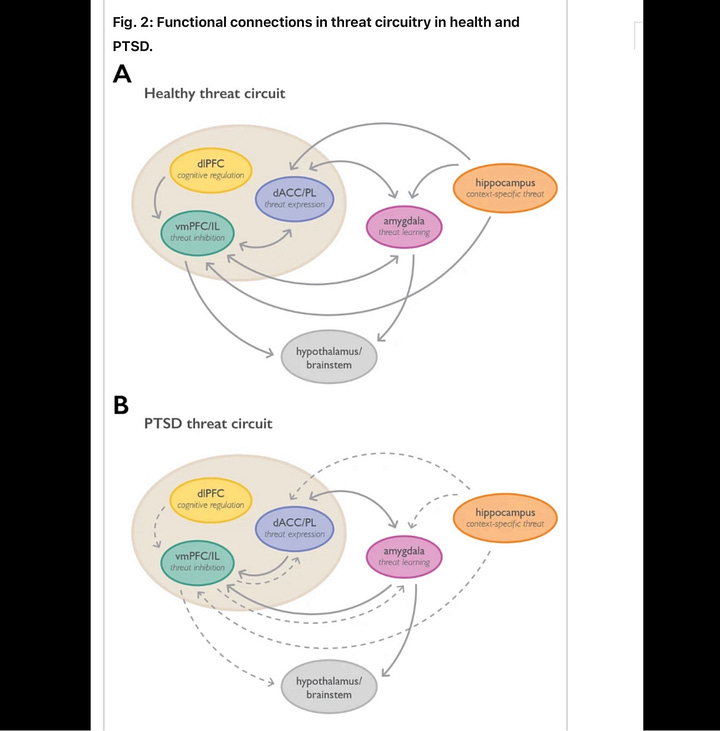
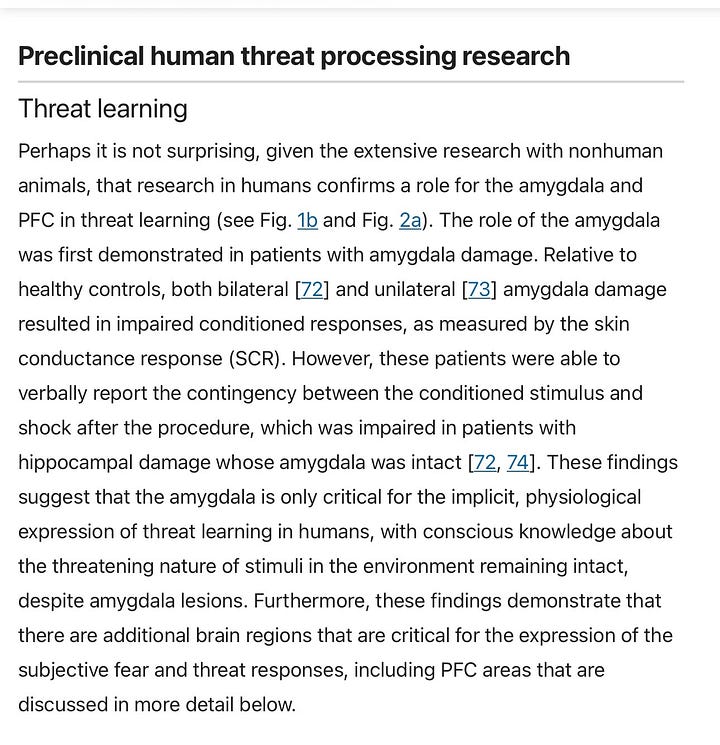
Recent research has shown that subcortical (subconscious) pathways are triggered by “invisible fearful faces” and for collision detection. It has also been shown that emotional tagging of events led by the amygdala can happen retroactively, reorganizing memory around trauma and fear.
These findings converge on several key points.
There is an identifiable brain circuitry that encodes negative/threat salience to the amygdala quickly and often without awareness.
The amygdala then biases memory systems and amplifies processing through the brain’s primary arousal network—the locus coeruleus—flooding the cortex with norepinephrine and sharpening the neural contrast of whatever just happened.
Emotional learning can both retroactively and proactively restructure what gets stored in memory—showing how a later jolt can tag earlier material, as well as overweight subsequent experiences.
The consensus in neuroscience is that there is a mechanism in the brain giving emotional, traumatic, and threatening experiences an outsized impact on what is processed subconsciously vs consciously. This overweighting is encoded into memory and amplified over time contributing to disorders like PTSD and chronic hypervigilance.
But this neurological mechanism also provides a way for people like Donald Trump and his propaganda apparatus a way to effectively control the emotions, and the minds, of millions of people. Systems that evolved to protect us from predators and disasters can be hijacked by language and imagery that simulate threat.
How It Works
Make America Great Again, the primary slogan of Donald Trump for a decade has within it an implied threat: “America was great before, but then [THREAT] happened. I alone can defeat it.” Of course, that threat is a wide variety of lies and exaggerations: trans people, immigrants, Haitian pet-eaters, DEI, and Venezuelan narco-terrorists come to mind. The list is endless and capable of generating an infinite variety of fear-generating narratives.
These fearful stories, repeatedly told by Trump or his proxies, activate the neurological mechanisms that I’ve outlined. The truth of the stories becomes less important because the threat they represent is stored in the amygdala, and activated by subconscious tagging and routing. Moreover, the deceitful bragging and grandiosity that Trump universally pairs with his traumatic stories is enhanced in the memory through emotional learning.
When someone becomes trapped in this rhetorical-neurological snare, both the fear of the threats Trump represents, and his self-praise, become increasingly amplified in the memory and amygdala. This creates a feedback loop in which Trump becomes both the generator and regulator of emotional arousal—his followers mirror his moods, and his enemies trigger their fear.
Mimetic Synchrony Is Neurological
I’ve described mimetic synchrony as the tendency of Trump followers to mirror his emotions and his projected fears in real-time, seemingly unconsciously. This gives them the external appearance of a school of fish or a flock of swallows, as opposed to a group of free-thinking individuals participating in the political process.
The neurological exploit I’ve described in this article provides a strong fit for the behavior anyone can see for themselves on social media. Trump’s hold on people is not just emotional, it’s subcortical—a subconscious cheat code that gives him and his allies a menu of triggers to choose from.
However, the brain, while vulnerable to being exploited, is also a marvelously elastic and resilient organ. Being trapped by this system is not necessarily a life sentence.
Countermeasures
Because this system works by hijacking natural biological pathways, the countermeasures are not ideological—they’re physiological, behavioral, and social. Here is an incomplete list of things people can do to ensure they do not fall victim to neurological entrapment, and ways that others can be helped:
If you get triggered, take 90 seconds off—consciously stop engagement. The time it takes norepinephrine to decay is ~90 seconds. This will allow your prefrontal cortex to regain priority.
Controlled breathing, body scanning, and interoception training (heartbeat, tension) give tools for lowering anxiety and re-engaging the insular cortex—which restores the salience network.
Get sleep and touch grass. Moving to another environment when feeling under threat, breaks associative loops, and gives the mind a way to rebuild context. People who are sleep-deprived suffer prolonged hypervigilance.
Name the affect, the emotion. Reappraise the source on the basis of its purpose. Write it down.
“This content is trying to scare me. Why is the source trying to do this?”
Reduce algorithmic consumption. Turn off autoplay and push notifications. Don’t fact-check when triggered; save it until you are emotionally centered.
Have a group of people that is dedicated to checking facts and checking in on each other’s emotional states—family, friends or colleagues who are not just going to go along with everything. Model calm disagreement to others.
While there is no easy solution to this problem, especially given the current political dynamics and rapid devolution of the democratic constitutional order, this does not have to be a permanent scenario. There are increasing signs that the hold Trump has on his base is fraying—and that the impacts of his policies will weaken it further. The more everyone knows about how his system of control works, the better we can all tear it down—bit by bit.
“Until you make the unconscious conscious, it will direct your life and you will call it fate.”
—Carl Jung, 1958, Psychology and Religion: West and East
If you are able to help me continue my work, please consider upgrading to a paid subscription. It really means a lot. Thank you!
Here are a few benefits to upgrading:
Live Zoom call each Sunday
Ability to comment and access all content
Wonderful, supportive community
Helping independent journalism fill in the gaps for our failing media
Thank you for reading and sharing my work. Grateful for your support.
If you’d like to help with my legal fees: DefendSpeechNow.org.
My podcast is @radicalizedpod & YouTube — Livestream is Fridays at 1PM PT.
Bluesky 🦋: jim-stewartson
Threads: jimstewartson


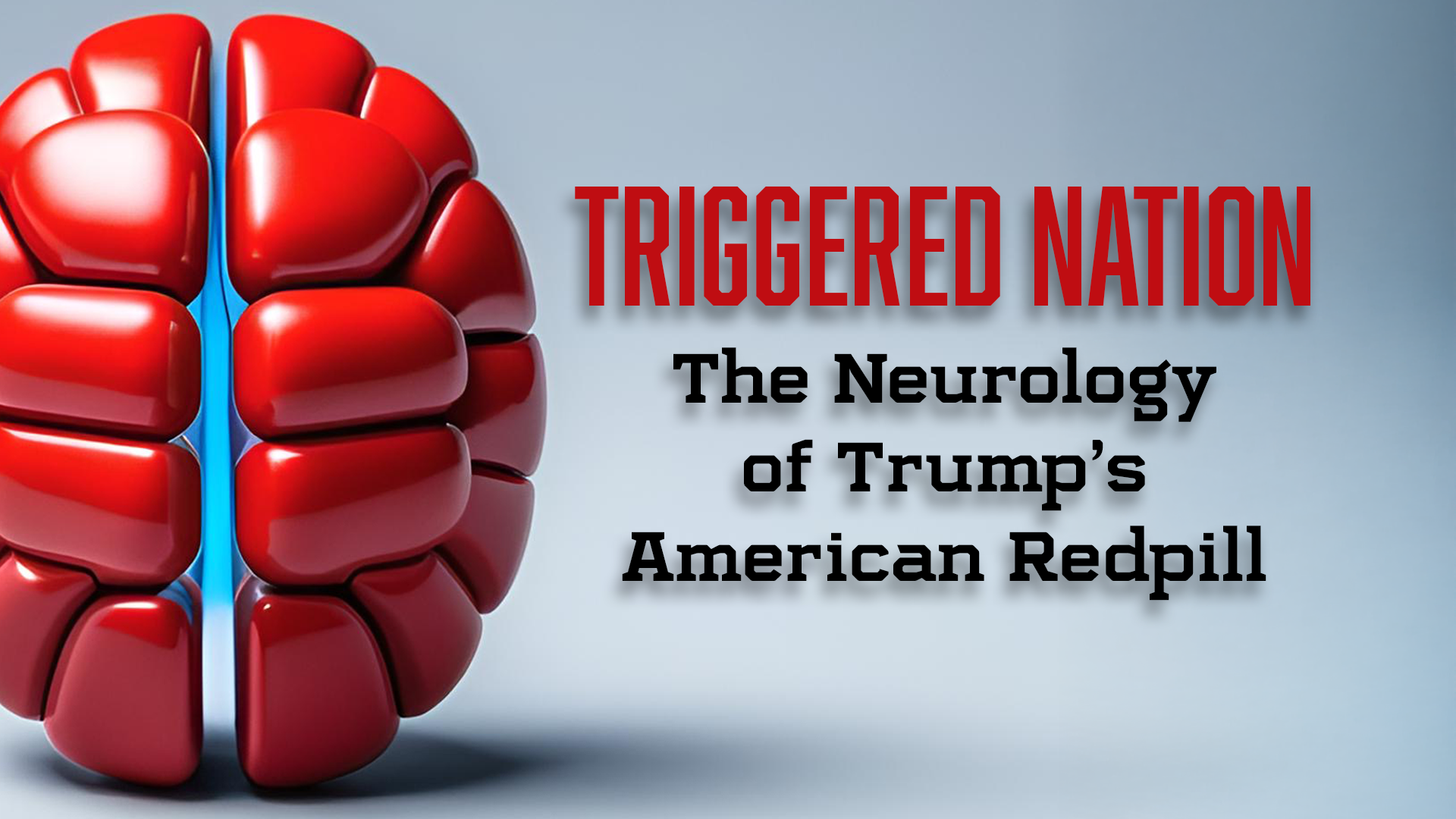


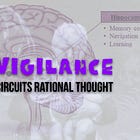

I’m grateful I never listened to enough of the Trump/MAGA propaganda to become traumatized by it. I’m beginning to wonder though if reading too much about Trump could be psychologically hurting me. I will be mindful to limit my daily consumption. Trump and his toxic movement is damaging to all of us to some degree. We must hold this evil man and his enablers and fellow scammers, including his family members, accountable after he and they are out of power.
That was another awesome read Jim. I wish, I wish your writing was required reading for all.